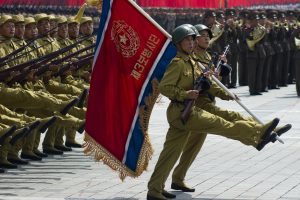North Korea announced it will launch a long-range missile sometime this month, perhaps as soon as February 8. The regime claims the payload will be merely a civilian “earth observation satellite.” Even if true, United Nations (UN) Security Council resolutions specifically preclude Pyongyang from “any further launches that use ballistic missile technology.” Both Pyongyang’s promised missile launch and its January 6th nuclear test are unambiguous violations of UN resolutions.
In recent years, North Korea has extended the height of the gantry at the Sohae launch facility. This suggests they might test a larger missile with greater range. However, the intended splashdown locations announced for the first and second stages are nearly identical to North Korea’s December 2012 missile launch, indicating that this month’s missile will likely be another Unha-3. The 2012 launch successfully put a satellite into orbit, demonstrating the same technology needed to launch an ICBM.
South Korea recovered and analyzed the stages of the 2012 missile. The South Korean Minister of Defense subsequently testified that it had an estimated range of 10,000 km and could have reached the continental United States. In 2015, the U.S. commanders of U.S. Forces Korea, Pacific Command, and NORAD publicly assessed that Pyongyang now has the ability to hit the United States with a nuclear weapon.
In response to last month’s nuclear test, the United States is pushing for stronger UN sanctions on North Korea—something China again stiffly opposes. Though some experts have speculated that Beijing would adopt a tougher stance toward North Korea under President Xi Jinping, China continues to prevent a meaningful U.N. response. Indeed, Beijing has repeatedly criticized allied reactions to North Korean threats, attacks, and violations rather that the precipitating actions by Pyongyang. For example, China is currently pressuring Seoul not to deploy the THAAD missile defense system rather than confronting Pyongyang to abandon its prohibited offensive nuclear and missile programs.
In parallel with UN Security Council debate, the U.S. Congress is finalizing legislation to impose tougher unilateral measures. This is spurred in part by lawmakers’ frustration over the Obama administration’s timid incrementalism of repeatedly hitting the snooze bar on more North Korean sanctions. Contrary to President Obama’s assertion that North Korea is the “the most isolated, the most sanctioned, the most cut-off nation on Earth,” there is much more the United States can do to pressure Pyongyang. In recent Congressional testimony, I highlighted the punitive measures the United States has applied to other nations for far less egregious violations, but not yet applied to North Korea. Those measures should be applied.
South Korea has pledged “searing consequences” against North Korea if it launches a missile, but still hesitates to implement appropriate responses. Legitimate responses would include: requesting U.S. deployment of the THAAD missile defense system to the Korean Peninsula; severing its involvement in the Kaesong industrial zone, and passing a North Korea Human Rights Act—something that’s been debated legislatively for a decade now.
Despite escalating North Korean nuclear and missile threats, South Korea has resisted implementing a more effective missile defense due to Chinese pressure and economic threats. The U.S. THAAD is more capable than anything South Korea has or will have available for decades.
The Kaesong joint economic venture with North Korea has utterly failed to achieve any of its political objectives. The goal was to induce North Korean economic and political reform and moderate the regime’s aggressive behavior. Successive South Korean administrations vowed repeatedly to restrict North Korea’s financial lifelines following U.N. violations and armed attacks, but all continued to funnel large amounts of cash to the regime through Kaesong. This has severely undermined the impact of international sanctions.
During the 12 years of Kaesong’s existence, North Korea has: conducted four nuclear and numerous missile tests; killed 50 South Koreans and maimed two others, and repeatedly threatened South Korea in vile and intimidating terms. Despite this, Seoul continues its self-flagellating behavior. It refuses to pull the plug on Kaesong out of a misplaced sense of nostalgia and fear of cutting “the last economic ties with the North.” Seoul should wean itself from the North’s extortion-based endeavor.
North Korea’s nuclear and missile tests are serious, irreparable violations of U.N. Security Council resolutions. Pyongyang remains openly defiant of the international community despite countless attempts to reach a diplomatic resolution. It is time for the United States and its allies to impose stronger sanctions and to beef up security against the growing North Korean military threat.
Bruce Klingner is a senior research fellow for Northeast Asia in the Asian Studies Center at The Heritage Foundation. He previously served as the CIA’s deputy division chief for Korea.

































